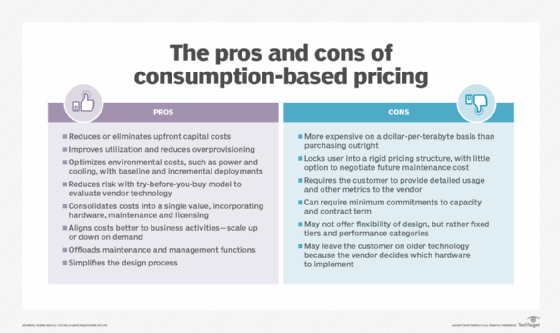utility storage
What is utility storage?
Utility storage is a service model in which a provider makes storage capacity available to an individual, organization or business unit on a pay-per-use basis. The customer purchases only the services, not the equipment itself, even if the equipment is housed on premises.
The utility model is sometimes called metered services or storage on demand. The term "utility" is used because the approach to service delivery is similar to public utilities, which try to accommodate fluctuating customer demand, while charging for resources based on usage. For example, power company customers typically pay only for the electricity they use, in addition to a small base fee.
As in the utility computing model, the purpose of utility storage is to use resources efficiently and reduce expenses. A use-based pricing structure can be more cost-effective for an enterprise than it would be to purchase, manage and maintain an infrastructure that can meet peak requirements but might be far more than what's normally required.
That said, utility storage is often based on a subscription model, and subscription fees can add up over the long-term, possibly exceeding the capital and operating expenditures that related to a more traditional approach to storage infrastructure. In addition, customers have nothing to show for their investment at the end of a subscription period, compared to the traditional approach where they own the equipment and might be able to sell it when it's no longer needed.

What types of utility storage are available?
Utility storage comprises a range of storage options. For example, a cloud-based storage service can be considered utility storage, as can an on-premises private cloud that offers storage services to support an enterprise's business applications. Consumption-based services based on on-premises infrastructure also fall under the utility storage umbrella.
Despite the different approaches, all the options offer on-demand storage that delivers the flexibility necessary to scale as needed, without having to invest in infrastructure that may be used only during peak operations. There are three basic models of utility storage:
- On demand. With this approach, vendors install storage systems configured with more capacity than immediately needed; users "turn on" additional capacity as required and are billed for the additional usage. For example, quantum as a service, Dell Technologies On Demand and Hewlett Packard Enterprise (HPE) GreenLake are examples of programs that offer pay-per-use on-premises storage services.
- Internal utility. In this scenario, an IT department pools its storage resources and implements the components necessary to deliver the storage as an on-demand service to the company's business units. In today's data centers, many IT teams are deploying private cloud storage and other cloudlike services to deliver compute and storage resources as services to business units, using cloud products from vendors such as Cisco, VMware, Nutanix and Red Hat.
- Off site. The most prevalent utility storage involves service providers that maintain off-site facilities and offer storage services on a pay-per-use basis. The services generally come with service-level agreements (SLAs) that guarantee quality of service (QoS). Most of today's off-site storage services are now offered by cloud service providers such as Google cloud storage, Amazon S3 and Microsoft Azure. Many organizations use cloud storage for off-site backup and data archiving, although they've also been turning to cloud storage to replace or augment on-site data storage.
Some sources treat the terms "utility storage" and "cloud storage" as one in the same, but it would be more accurate to say that cloud storage is a type of utility storage within the off-site category, along with similar types of storage as a service (STaaS) offerings. That said, the term "utility storage" is not used nearly as often these days as it was in the past.
The concept of STaaS can also cause some confusion because it can apply either to the on-demand utility storage model or to the off-site model. STaaS can include any managed service provider (MSP) that supplies a customer with access to storage resources, whether on premises or through a public cloud platform.

For example, HPE GreenLake offers customers on-premises STaaS. In this program, HPE delivers, deploys and manages the storage systems. Customers pay only for the storage they use, and they can scale that storage on demand, similar to cloud-based STaaS offerings such as Amazon S3. In either case, customers get fully managed services, without having to overprovision resources or pay for systems that sit idle much of the time.
See also: cloud storage, storage virtualization, thin provisioning, storage provisioning







